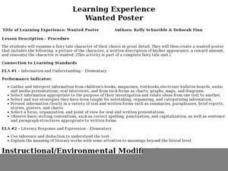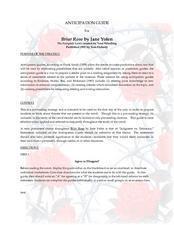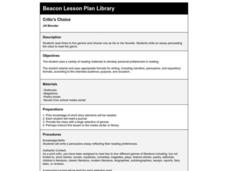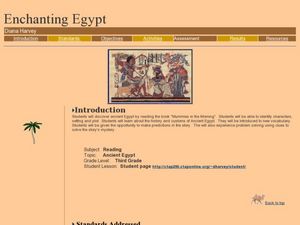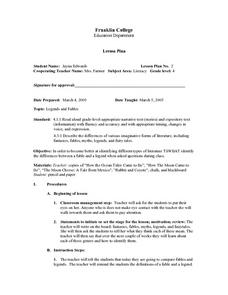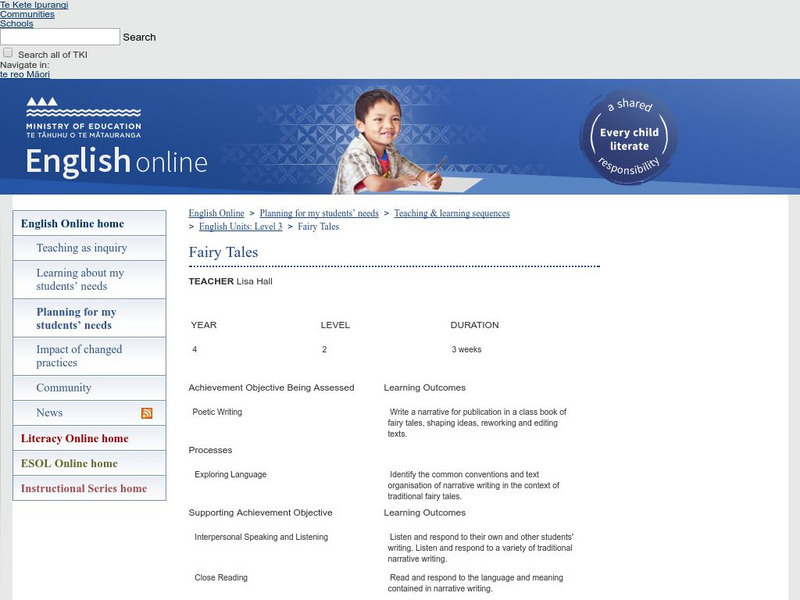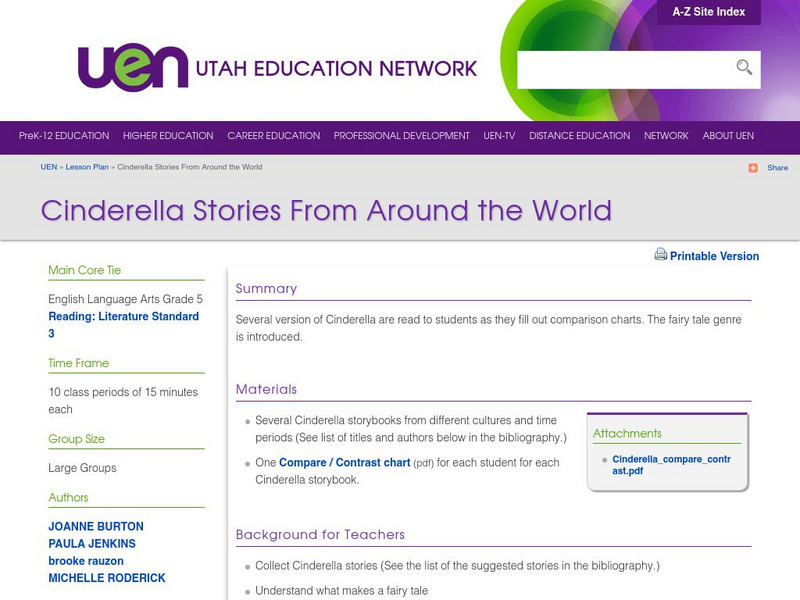Curated OER
Nibble, Nibble, Little Mouse
Students complete activities to analyze points of view in different texts. In this point of view lesson, students read Hansel and Gretel and The Magic Circle and discuss the points of view. Students choose a character from the story and...
Curated OER
Wanted Poster
Students examine a fairy tale character of their choice in great detail. They create a wanted poster that includes the following: a picture of the character, a written description of his/her appearance, a reward amount, and reasonthe...
Curated OER
Once Upon a Pop-Up Book
Third graders compile their writings into pop-up books after reading "The Jolly Postman: Or Other People's Letters." The book contains letters, invitations, essays, and narratives they have written previously. The project also includes...
Curated OER
The Princess's Point of View
Everyone wants to be part of a royal family. Let your pupils experience the privilege of royalty by rewriting the story The Frog Prince from the point of view of the princess. While the story line remains the same, perspective is bound...
Curated OER
Establishing a Point of View in Narratives
Fourth graders investigate the concept and take the opportunity to both identify and to construct point of view in narratives. Additionally, 4th graders practice identifying and sequencing main events.
Curated OER
What Makes a Fable?
Third graders explore fables. In this fables lesson, 3rd graders use Venn Diagrams to organize information about 2 fables they will read. Students work in groups to fill out the diagrams and share their results with the class. Students...
Curated OER
Briar Rose: Anticipation Guide
Prepare your readers for Briar Rose with an Anticipation Guide that asks them to agree or disagree with a series of statements that reflect issues raised by Jane Yolen’s narrative about a young girl’s research into her grandmother’s...
Curated OER
Tell Me a Whopper!
Sixth graders investigate tall tales as a literary genre. They listen to a number of tall tales to discover how exaggeration is used as a story element. They write and publish a tall tale using word processing software. They illustrate...
Curated OER
Modern Day Characters from Children's Literature
Pupils read several studenT fairy tales, nursery rhymes, or folk tales. They compare themes and narratives in each version. They rewrite a story that they have read, placing the characters in a contemporary setting and include...
Curated OER
A Dream of Classic Perfection
Students look at how Greek classical art and philosophy influenced the French Revolution. In this French Revolution lesson plan, students use primary sources, Neoclassical art, to look at how they show what society was like during this...
Curated OER
Catch Me If You Can: Over and Under
Students read a story. In this vocabulary skills lesson, students read The Gingerbread Man, use flannel cut outs to re-enact the gingerbread man running over and under.
Curated OER
Critic's Choice
Third graders read three to five genres and choose one as a favorite. They write an essay persuading the class to read the genre. This lesson serves as a nice introduction to different styles of literature.
Curated OER
Sondheim: Voice of Cultural Change
Students explore Stephen Sondheim's contributions to musical theatre in the context of the dramatic cultural shift that occurred in American life in the late 1950s, 1960s, and 1970s.
Curated OER
Enchanting Egypt
After reading the Magic Tree House book Mummies in the Morning, learners talk about Ancient Egypt. They identify the plot, characters, setting, etc., explore vocabulary terms, and construct a pyramid. This will motivate your class to...
Curated OER
Legends and Fables
Fourth graders identify and discuss the differences between legends and fables. They define fable and legend, then as a class take turns reading our books. Students select two of the stories, and complete a Venn diagram, comparing one...
New Zealand Ministry of Education
Nz Ministry of Education: Fairy Tales
After studying the structure of narratives through fairy tales, students will plan and write their own fairy tales using a narrative planning sheet (see learning task 2). Children will write their own fairy tale, stopping to share,...
ReadWriteThink
Read Write Think: Comics in the Classroom: Introduction to Narrative Structure
Contains plans for four lessons that teach students about narrative plot structures by using "The Three Little Pigs" fairy tale or a similar story. In addition to objectives and standards, this instructional plan contains links to sites...
Utah Education Network
Uen: Cinderella Stories From Around the World
In this lesson plan, 5th graders will compare and contrast different versions of the fairy tale "Cinderella." Students will use a compare and contrast chart chart. After the shared readings, students will use all the elements of a fairy...
Writing Fix
Writing Fix: Fracturing Tales Through Titles
Students read The Wolf Who Cried Boy by Bob Hartman and then write their own fractured fairy tales using first-person point of view and dialogue. Teacher and student instructions are provided along with student writing samples, an...
ReadWriteThink
Read Write Think: Reader Response in Hypertext: Making Personal Connections
Young scholars write a narrative of place, a character sketch, an extended metaphor poem and a persuasive essay then link all four texts to quotations they have selected from a novel.
British Library
British Library: 20th Century: Angela Carter's the Bloody Chamber
These activities offer students a unique opportunity to examine how a writer crafts a narrative. By exploring many of Angela Carter's early drafts, students will uncover how she created her ground-breaking short story collection, "The...
Alabama Learning Exchange
Alex: Retelling Is Fun!
The purpose of this lesson is to get students involved with retelling activities, including writing a narrative and dramatic play.



